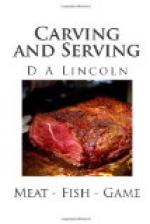Should your preference be asked, and you have any, name it at once, provided there is also enough for others who may prefer the same kind. Remember there are only two fillets, or side-bones, or second joints; if you are the first to be served, do not test the skill of the carver by preferring a portion difficult to obtain.
Many of these cautions may seem uncalled for, but they have been suggested by personal observation of their necessity. People of good breeding would never err in any of these ways; but alas, not all people are well bred, and innate selfishness often crops out in small matters.
The following explicit directions have not been taken from books. They were given to the writer a few years ago by one who was an adept in the art, who had received her instruction from a skilful surgeon, and who at her own table gave a practical demonstration of the fact that a lady can not only “carve decently and in good order,” but with ease and elegance.
SPECIAL DIRECTIONS.
TIP OF THE SIRLOIN, OR RIB ROAST.
It is easier to carve this joint by cutting across the ribs, parallel with the backbone, but that is cutting with the grain; and meat, especially beef, seems more tender if cut across the grain.
Place it on the platter with the backbone at the right. If the backbones be not removed before cooking, place the fork in the middle and cut close to the backbone down to the ribs. Shave off the thick, gristly cord near the backbone, as this, if left on, interferes with cutting thin slices. Then cut, from the side nearest you, thin uniform slices parallel with the ribs. Run the knife under and separate them from the bone. Many prefer to remove the bone and skewer the meat into a roll before cooking. It may then be laid, flesh down, on the dish, and carved across the top horizontally in thin slices; or if you find it easier, place it with the skin surface up, and carve down from the flesh side nearest you.
This style of serving is generally preferred, but there are advantages in retaining the bone; for the thin end when rolled under is not cooked to such a nice degree of crispness, and the slices are usually larger than desired. Again, the ribs, by keeping the meat in position, secure for it a clean cut, and not one broken and jagged, and the thin end may be served or not, as you please.
SIRLOIN ROAST.
The backbone or thickest end should be at the right end of the dish.
Carve a sirloin roast by cutting several thin slices parallel with the ribs. Then cut down across the ribs near the backbone, and also at the flank end, and separate the slices.
The slices should be as thin as possible and yet remain slices, not shavings. Turn the meat over and cut out the tenderloin and slice it in the same manner across the grain; or turn the meat over and remove the tenderloin first. Many prefer to leave the tenderloin to be served cold. Cut slices of the crisp fat on the flank in the same way, and serve to those who wish it. This is a part which many dislike, but some persons consider it very choice. Always offer it unless you know the tastes of those whom you are serving.




